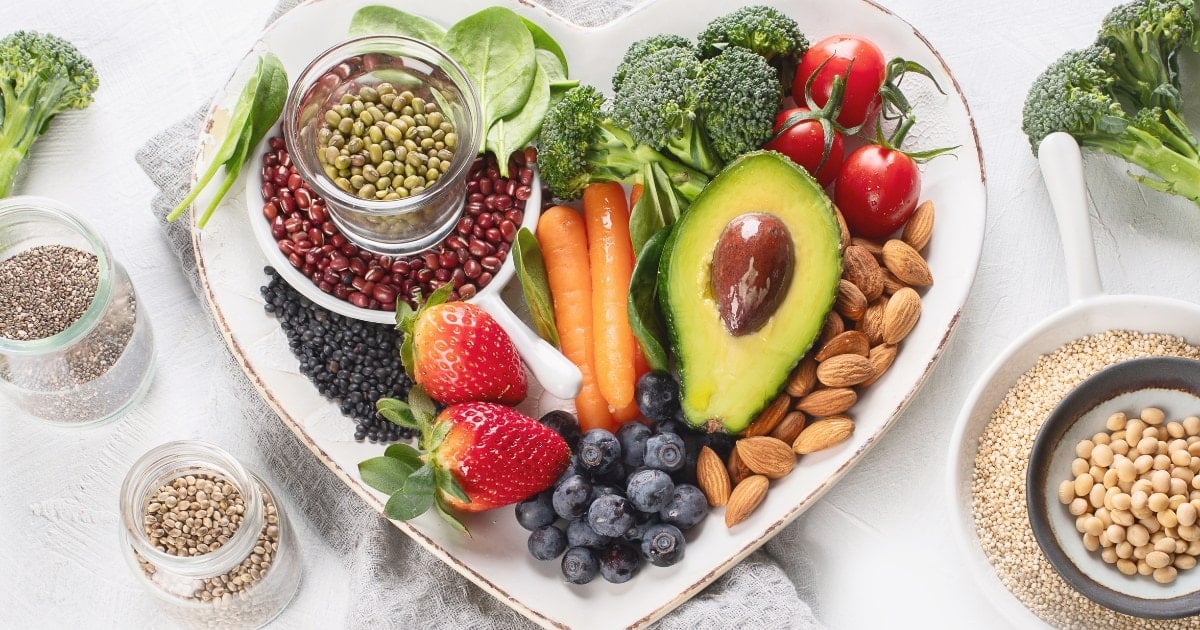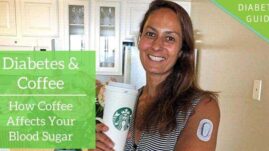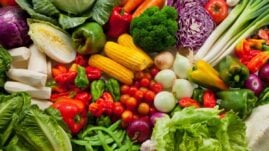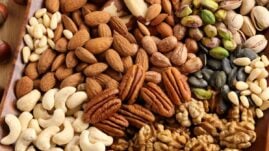In recent years, plant-based diets have moved into the mainstream, and many people living with diabetes today are considering adopting a vegan or otherwise plant-focused diet.
In this article, we will look at the pros and cons of following a plant-based diet as a person with diabetes based on scientific studies.

Table of Contents
- The case for following a plant-based diet
- Diet terminology
- What’s the difference between a vegan diet and a WFPB diet?
- What changes can I expect with my diabetes when I eat a WFPB diet?
- What if I can’t handle beans on a plant-based diet?
- Are there any special considerations for eating plant-based if I have diabetes?
- How do I get started on a plant-based diet?
- Final thoughts
The case for following a plant-based diet
Although being diagnosed with type 1, type 2, or prediabetes is a life-changing event, there are ways to reduce the symptoms, complications, and stress associated with diabetes.
One of the most significant ways to decrease the burden is to switch to a more whole-food, plant-based lifestyle.
In fact, in 2018, the American Association of Clinical Endocrinology (AACE) and the American College of Endocrinology (ACE) released guidelines recommending a plant-based diet as the ideal nutrition plan for individuals with diabetes. This is because it enhances overall health and enables better control over the condition.
In 2022, the American College of Lifestyle Medicine (ACLM) released an expert consensus statement endorsed by the AACE, supported by the Academy of Nutrition and Dietetics (AND), and co-sponsored by the Endocrine Society stating that “diet as a primary intervention for T2D is most effective in achieving remission when emphasizing whole, plant-based foods with minimal consumption of meat and other animal products.”
Today, poor or “suboptimal” nutrition is a major cause of the increasing epidemic of obesity, chronic disease, and premature deaths worldwide.
A suboptimal diet is high in sodium, saturated fats, and added sugar, while being low in healthy fats, dietary fiber, and other important nutrients. These nutrients can be found in foods like fruits, vegetables, nuts, seeds, whole grains, and legumes.
Eating a suboptimal diet was associated with 45.4 percent of all deaths relating to heart disease in the United States in 2012.
However, studies reveal that when someone with diabetes or prediabetes switches from a suboptimal diet to a more WFPB diet, not only can it significantly reduce insulin requirements and lower their A1c (a measure of glucose control over the previous 2 to 3 months), but it can also increase weight loss, decrease total cholesterol, decrease depression, and increase quality of life and physical well-being.
Now let’s dig into some of the research.
Diet terminology
While plant-based diets are generally healthy and linked to a reduced risk of several chronic diseases, the extent of their benefits in managing diabetes varies depending on the specific type of plant-based diet adopted.
There are many versions of plant-based diets, but for brevity, we will be discussing the following:
- a vegetarian diet
- a vegan diet
- a WFPB diet
Vegetarian: People following a vegetarian diet do not eat any meat, poultry, or fish, but may consume dairy products and/or eggs.
Vegan: Those following a vegan diet do not eat any foods derived wholly or partly from animals.
WFPB: People consuming a WFPB diet avoid most or all animal products and focus on high consumption of whole, minimally processed, and unrefined ingredients from foods such as fruits, vegetables, legumes, seeds, whole grains, nuts, and seeds. This diet is typically low in fat, high in fiber, and moderate in protein.
What’s the difference between a vegan diet and a WFPB diet?
One key reason it is important to differentiate between a vegan and a WFPB diet is the quality of food. The higher quality is what determines the level of health benefits.
For example, if a person is only living by the vegan rule to not eat animal products, they can technically indulge in a diet that is highly processed, high in sodium, high in sugar, high in saturated fat, and low in dietary fiber.
Theoretically, a strictly vegan diet could consist of the following:
- Breakfast: Betty Crocker Bisquick Original Pancakes topped with Golden Griddle Syrup (made with corn and high-fructose corn syrup)
- Lunch: Smuckers Peanut Butter and Jelly sandwich (made with white bread)
- Snack: Lay’s Classic Potato Chips (high in salt)
- Dinner: Thai Kitchen Hot & Sour Noodle Soup Bowl and a serving of Ore-Ida Golden Tater Tots with a side of ketchup (more high-fructose corn syrup and sodium, among other issues)
- Dessert: 1 large Duncan Hines California Walnut Brownie Mix topped with Duncan Hines Chocolate Whipped Frosting (with corn syrup)
While a vegan WFPB diet would look more like:
- Breakfast: Blackberry smoothie bowl topped with coconut flakes, pepitas (pumpkin seeds), and fresh fruit
- Lunch: Sweet potato loaded with mashed avocado and roasted chickpeas
- Dinner: Spaghetti squash noodles with extra-virgin olive oil and garlic
- Dessert: Hemp seed energy bites
Both diets are vegan, but there is a massive difference in the quality and nutrition of the food eaten.
What changes can I expect with my diabetes when I eat a WFPB diet?
Once you start, you may see a positive change in your blood sugar levels almost immediately, or they could gradually decrease over the next couple of weeks to months.
Clinical changes you may see are a reduction in insulin resistance and insulin requirements, a lowered A1c, weight loss, and a decrease in total cholesterol and blood pressure.
What changes will I see with my insulin on a plant-based diet?
Looking specifically at insulin, doses may need to be adjusted with the help of your healthcare provider (HCP), such as a primary care physician (PCP), endocrinologist, or certified diabetes care and education specialist (CDCES). The reduction can vary greatly depending on your needs and how closely you stick to the diet.
The parameters that may need to be adjusted would be the following:
For those on multiple daily injections (MDI):
- Correction factor
- Insulin-to-carb ratio
- Long-acting insulin
For insulin pump users:
- Correction factor
- Insulin-to-carb ratio
- Basal rate(s)
It is not recommended that you adjust these settings without the guidance of an HCP. However, you can expect that your correction factor and insulin-to-carb ratio will increase. This may be confusing at first glance, but these numbers use an inverse ratio, meaning the higher the number, the less insulin is used.
For example, let’s say you have a 1:12 insulin-to-carb ratio, meaning you need 1 unit of short-acting insulin to cover 12 grams of carbohydrates.
You then start eating a WFPB diet and notice that when giving insulin for 12 grams of carbohydrates, your dose is now causing low blood sugar. Your HCP would then increase your insulin-to-carb ratio.
In this example, we will say it is increased to 1:15. This means that now 1 unit of short-acting insulin will cover 15 grams of carbohydrates in order to bring your blood sugar back to target after a meal or snack.
This same situation may also occur for your correction factor, or the amount of insulin you need to bring your blood sugar into target range. For example, if you are used to a 1:25 (1 unit for 25 mg/dL) correction factor, after starting a WFPB diet, that correction may be too much and you may need to increase your ratio.
Consult with your physician or a CDCES when changing these settings. As with any significant dietary change, it is important to closely monitor your blood sugar and adjust your insulin as needed.
For those who see an increase in their blood sugar levels with a WFPB diet, it does not necessarily mean that this new way of eating is not working, but rather that you may need to change your approach or that your body may just need additional time.
Remember, for the positive health benefits to occur, you need to make sure to eat a WFPB diet that is low-fat, minimally processed, and, of course, plant-based. Focusing on consuming more low-glycemic index (GI) foods for even more effective blood sugar management.
Consult a registered dietitian (RD) if you have any questions about what to eat on this type of diet.
Will I see a blood pressure change eating a WFPB diet?
Many people who have diabetes are also on blood pressure medication. If this is you, make sure to bring up your blood pressure treatment with your HCP before making the switch to this diet.
During that visit, it is also important to discuss low blood pressure symptoms and treatment. The new eating pattern may help lower your blood pressure levels naturally, necessitating an adjustment in the dose of your blood pressure medicine.
Should I talk to my healthcare provider before starting a plant-based diet?
Before starting a WFPB diet, consult with your HCP to discuss any medication changes that may become necessary due to decreased insulin resistance and weight loss.
Also, make sure you know how to treat low blood sugar. An abrupt switch to eating a WFPB diet from your usual meal plan may result in a significant decrease in insulin resistance, which means that those with diabetes who use oral diabetes medicines or insulin may experience low blood sugar.
What if I can’t handle beans on a plant-based diet?
According to Plant-Based Diets: A Physician’s Guide, the ideal recommended intake for legumes (lentils, beans, peas) on a plant-based diet is about 1 1/2 cups per day. For the average person, that may seem like a lot and may even give you a little anxiety due to past experiences with beans.
Some people may feel that they do not tolerate beans because of flatulence. But rest assured, adding beans and other legumes to your diet is a gradual process, and your body will adjust over time as you regularly consume these foods.
Start with smaller legumes such as peas or lentils because they are easier to digest. Also, if you are soaking dry beans, make sure to soak thoroughly and discard the water used to soak them.
When introducing legumes into your diet, start with small amounts and gradually increase to 1 1/2 cups per day, depending on your tolerance. Remember, boosting fiber intake through legumes necessitates higher hydration levels to help digestion.
For people who cannot tolerate whole legumes due to digestive conditions, alternatives like tempeh and tofu — both minimally processed and fermented bean products — can be gentler on the stomach while still offering ample plant-based protein.
Legumes are exceptionally nutritious and filling due to the high amount of dietary fiber and plant protein. They are a staple of a WFPB diet, but again, make sure to add them gradually over a few weeks if you are switching from a diet that does not usually include beans.
Are there any special considerations for eating plant-based if I have diabetes?
Vitamin B12, also known as cobalamin, is a nutrient the body needs in order to make red blood cells, nerves, and DNA, and carry out other necessary functions. Vitamin B12 cannot be made by the body, so it is important to get this either from food or through supplements.
Vitamin B12 is primarily found in meats, eggs, poultry, and other foods that come from animals. Plant-based sources of vitamin B12 are limited to shiitake mushrooms (small amounts of B12), algae (seaweed/nori), and fortified foods, such as nutritional yeast. With very few plant-based sources, a strictly vegan diet can cause a vitamin B12 deficiency.
Additionally, some diabetes drugs, including metformin at certain doses, have been linked to decreased levels of vitamin B12. Therefore, people with diabetes treated with metformin, especially large doses (such as ≥ 1,500 milligrams per day) and for longer durations (> 2 years), should regularly be screened for a B12 deficiency.
Other factors that can increase the risk of a vitamin B12 deficiency are being over the age of 50 and having a weight-loss surgery such as gastric bypass.
What are vitamin B12 deficiency symptoms?
Vitamin B12 deficiency is serious and early detection is important. Vitamin B12 deficiency can cause tiredness, constipation, weakness, loss of appetite, weight loss, and megaloblastic anemia.
Having a vitamin B12 deficiency can also increase nerve problems such as numbness and tingling in the hands and feet. Other symptoms of vitamin B12 deficiency include problems with balance, confusion, depression, poor memory, dementia, and soreness of the mouth or tongue.
A thorough HCP evaluation may be able to detect a vitamin B12 deficiency, but a blood test is needed to confirm the diagnosis.
Will I get enough protein eating a WFPB vegan diet?
Sufficient protein is needed to supply the dietary nitrogen and amino acids our cells require for growth and maintenance.
The United States Department of Agriculture (USDA) recommends at least 46 grams of protein for adult females and 56 grams for adult males per day. (Protein recommendations may differ for people with chronic kidney disease [CKD].)
A WFPB diet can more than meet this amount of protein by including plants that are rich in protein, such as beans, peas, lentils, peanuts, almonds, quinoa, chia seeds, hemp seeds, and soy foods.
Eating a diet entirely based on plants provides all the essential amino acids and nutrients needed, even without the use of special food supplements or combinations. Additionally, eating a diet where the protein comes exclusively from plants has been associated with reductions in body weight and insulin resistance.
What about kidney health on a WFPB vegan diet?
An especially alluring benefit to those with a long-standing history of diabetes is that a higher intake of vegetable protein is associated with lower rates of kidney failure, meaning that a diet that replaces animal protein with plant protein has been found to be more protective for kidney health.
Traditionally, dietary recommendations for people with chronic kidney disease have been to limit the intake of many plant-based foods due to their high potassium levels. However, this recommendation is being reevaluated in light of the multiple benefits associated with a more whole-foods, plant-based (WFPB) diet.
These benefits include improved gut health, a reduction in toxin formation, and an increase in dietary fiber, which enhances bowel regularity and the production of short-chain fatty acids. Short-chain fatty acids help stop the growth of harmful gut bacteria, improve mineral absorption (such as calcium), reduce the blood sugar response to food, and promote feelings of fullness and weight loss.
A condition called metabolic acidosis in CKD is aggravated by eating a diet high in meat and refined cereal grains, which increases the dietary acid load. On the other hand, fruits and vegetables help accomplish the opposite by neutralizing acid.
High phosphorus levels are also a known cause of cardiovascular events and death in people with CKD. However, phosphorus intake is also lower while eating a more WFPB diet, since the majority of high-phosphorus sources come from highly processed convenience foods, meats, dark-colored sodas, and dairy products. Certain plant-based foods are also higher in phosphorus, like beans and nuts, but the intestinal absorption of phosphorus from plant-based sources is significantly lower than from animal-based sources.
Another benefit of a WFPB diet is its high content of magnesium and vitamin K, nutrients often deficient in people with CKD. Eating a varied plant-based diet can help address these deficiencies. Additionally, the anti-inflammatory properties and the ability to reduce oxidative stress associated with a WFPB diet may contribute to slowing the progression of CKD.
For people with CKD, managing dietary potassium is still recommended, especially when consuming a plant-rich diet. Certain cooking techniques can help reduce potassium levels in vegetables.
These techniques include boiling or leaching, where vegetables are cut into small pieces and soaked in a large amount of water for several hours, then drained and rinsed before cooking. This process helps to leach out some of the potassium, making these foods more suitable for a low-potassium diet.
However, if you have CKD, it’s essential to consult your HCP or an RD for personalized guidance on managing potassium intake through diet and cooking methods. Careful management of potassium levels is crucial when following a WFPB diet, as dietary needs and health considerations can vary significantly among people with CKD.
How do I get started on a plant-based diet?
Here are eight tips to get started on a WFPB diet with diabetes:
Base your meal on vegetables. Fill at least half your plate with a variety of non-starchy vegetables, such as mixed leafy greens, green beans, roasted Brussels sprouts, cauliflower, broccoli, asparagus, and cabbage.
Make meat an accent. If and when you eat meat, reduce the amount and make it the accent, rather than the main focus of your meal.
Choose whole foods. Opt for foods that are whole, minimally processed, or unrefined, such as fruits and vegetables, legumes, whole grains, nuts, and seeds.
Choose high fiber. The higher the fiber per serving, the less the food tends to cause a blood sugar response, which can be exceptionally helpful for those with diabetes. Choose foods such as berries, cruciferous vegetables, nuts, seeds, and leafy greens.
Upgrade your fats. Trade out highly processed and saturated fats for healthy fats from whole plant sources, such as avocados, olives, nuts, and seeds. Limit fats from oils — you will get more nutrients from eating the whole food.
Build a “Buddha Bowl.” Fill a bowl with salad greens such as romaine, spinach, kale, or other leafy greens and top with a variety of legumes and vegetables, such as beans, peas, edamame, Brussels sprouts, and sautéed mushrooms.
Eat fruit for dessert. Enjoy a bowl of fresh berries, a crisp apple with peanut butter, or a serving of blended banana “nice cream” to satisfy your sweet tooth after a meal.
Consult with your doctor. As you change your eating habits, it is important to adjust insulin and medications with the guidance of your healthcare team.
Final thoughts
Eating a WFPB diet has many potential health benefits for people living with diabetes. However, it is not necessary to completely eliminate animal products from your diet to receive these benefits.
Plant-based, by definition, means that the foundation of your meals comes from plants, but that does not mean that all animal products must be completely removed from your diet.
Eating a highly restrictive diet, such as one without any animal products, can be challenging to maintain and may contribute to disordered eating patterns in some people.
Therefore, if you decide to eat a WFPB diet, it should be seen as a lifestyle, rather than an extreme diet that does not allow for wiggle room.





Monica
My 12 year old daughter was dx T1D in may 2020. She’s been on a WFPB diet all her life, since I’ve been vegan for 15+ years, with a focus on a WFPB ingredients in the last 11 years.
After reading Mastering Diabetes, we’re now more than ever convinced that this diet is the way to keep her healthy long term: even though she’s going through puberty, her A1C is around (5.9 – 6.2), while on MDI, and we’re hoping that once she’s on a pump, we can improve on that. She eats an average of 300+ carbs a day, whole grains mostly (she has celiac disease as well, so that’s another criteria we need to follow when feeding her), fruits, veggies, pulses, tofu etc. We do occasionally let her have a vegan gf treat, because she’s a kid, but the majority of her calories come from what the Mastering Diabetes book calls “green” or “yellow” foods; her total fast acting insulin is between 11-15 units a day. Her lipids are excellent, total cholesterol below 150, so for me as a parent, this is the best way to make sure she’s growing up as healthy as possible, not just from a diabetic patient standpoint, but taking her whole present and future health into consideration.
Catherine
I was happy on a vegan diet, however, I’m diabetic and could not get enough protein since I cannot eat carbohydrates. I had to add meat back in so my hair and nails would grow back and my teeth and gums would become healthy again. If I could figure a way to get more protein to prevent those issues, I could go back, but until then, I’ll have to do the best I can.
Andrew Lawless
This is a great post. I am a proponent of the alkaline diet because all foods that are bad for us diabetics are vegan as you rightly point out. Another factor is increased risk for heart disease, which a plant based diet reduces. There are some critics that claim that a plant based diet cannot be healthy because it lacks Vitamin B. But cows, which are vegan, do not generate vitamin B 12 either. They take it in through the dirt they are eating with grass.
Iranians have a saying that you need to feed kids a spoon full of dirt every day to keep them healthy. Our obsession with keeping everything clean, radiated, pasteurized, sanitized or fried makes us sick. Make sure you eat locally sourced, organic greens with them dirt on it, and you won’t need supplements.
Keep amazing posts like this mine coming. Love it.